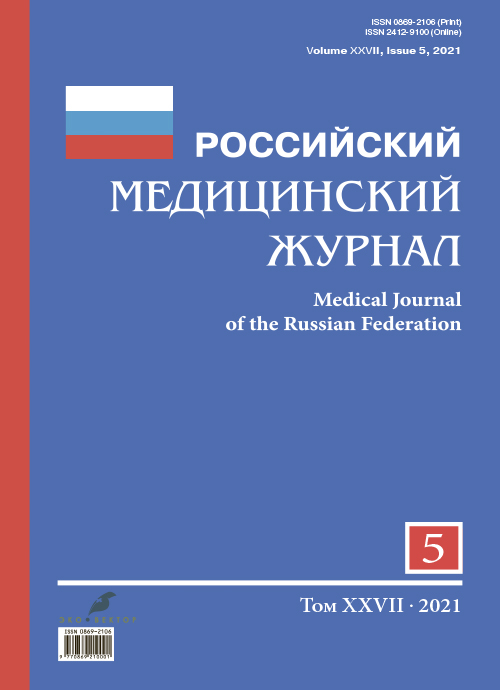Choice of the method for eliminating postburn shoulder joint contractures
- Authors: Sarygin P.V.1, Stepanova Y.A.1, Gushchina N.V.1
-
Affiliations:
- A.V. Vishnevsky National Medical Research Center
- Issue: Vol 27, No 5 (2021)
- Pages: 455-463
- Section: Clinical medicine
- Submitted: 21.06.2022
- Accepted: 21.06.2022
- Published: 15.09.2021
- URL: https://medjrf.com/0869-2106/article/view/108913
- DOI: https://doi.org/10.17816/0869-2106-2021-27-5-455-463
- ID: 108913
Cite item
Abstract
BACKGROUND: In the Russian Federation, over 400,000 patients with thermal injuries are registered yearly, with approximately 30% of them requiring hospitalization. Physicians pay special attention to the rehabilitation of patients with complications of deep burns. According to several authors, deep burns occur in 47% of cases. The most common complications of deep burns are contractures and limb deformities. Shoulder contractures occur in over 50% of patients. The outcomes and terms of a patient’s return to active social and working life depend on the timeliness and selection of an optimal surgical intervention from a wide range of reconstructive and plastic techniques.
AIM: This study aimed to improve the functional and esthetic results of surgical treatment in patients with postburn shoulder joint contractures.
MATERIALS AND METHODS: From 2011 to 2020, 198 patients underwent surgery, including 59% women and 41% men. Right shoulder, left shoulder, and right and left shoulder simultaneous joint contractures occurred in 54.5%, 38.5%, and 7% of cases, respectively. The patients’ age ranged from 18 to 72 years, and 99% of them were of working age. The scope of preoperative examination included clinical data, photographic documentation, duplex vascular scanning, and determination of the degree of contracture using a mechanical goniometer. Patients with grade I, II, and III shoulder joint lesions accounted for 29%, 60%, and 11% of the total number of cases, respectively. Early surgical rehabilitation prevents the development of secondary myogenic and arthrogenic contractures and accelerates the patient’s social reintegration. Local tissue plasty using the armpit adipodermal tongue-shaped flap, a nonperforated full-layer or split skin graft, a rotated flap based on perforating vessels, and the expander stretching method were used to eliminate contractures.
RESULTS: Bacterial infection, total and marginal necrosis, hematomas, and seromas were not observed in the immediate postoperative period. Complete elimination of the shoulder joint contracture was achieved in 63% of cases, whereas joint mobility increased by over 60° in 30% of patients.
CONCLUSIONS: The algorithm presented for choosing a method of surgical rehabilitation for patients with shoulder joint contractures leads to an increase in the efficiency of reconstructive surgery after burn injuries.
Full Text
About the authors
Pavel V. Sarygin
A.V. Vishnevsky National Medical Research Center
Email: psarygin@mail.ru
ORCID iD: 0000-0003-3787-2147
MD, Dr. Sci. (Med), Professor
Russian Federation, 27, Bolshaya Serpukhovskaya str., Moscow, 117997Yulia A. Stepanova
A.V. Vishnevsky National Medical Research Center
Email: stepanovaua@mail.com
ORCID iD: 0000-0002-5793-5160
MD, Dr. Sci. (Med)
Russian Federation, 27, Bolshaya Serpukhovskaya str., Moscow, 117997Nataliya V. Gushchina
A.V. Vishnevsky National Medical Research Center
Author for correspondence.
Email: gnv1009@gmail.com
ORCID iD: 0000-0001-9985-760X
Russian Federation, 27, Bolshaya Serpukhovskaya str., Moscow, 117997
References
- Zlenko VA. Khirurgicheskoe lechenie posleozhogovykh rubtsovykh kontraktur krupnykh sustavov konechnostei [dissertation]. Moscow; 2011. (In Russ).
- Ruchin MV. Vosstanovlenie funktsii i anatomicheskoi tselostnosti struktur oporno-dvigatel’’noi sistemy u patsientov s glubokimi ozhogami [dissertation]. Moscow; 2019. (In Russ).
- Grishkevich VM., Moroz VY. Khirurgicheskoe lechenie posledstvii ozhogov nizhnikh konechnostei. Moscow; 1996. (In Russ).
- Grechishnikov MI. Algoritm khirurgicheskogo lecheniya bol’nykh s posledstviyami ozhogovoi travmy [dissertation]. Moscow; 2015. (In Russ).
- Yudenich VV, Grishkevich VM. Rukovodstvo po reabilitatsii obozhzhennykh. Moscow: Meditsina; 1986. (In Russ).
- Taylor GI, Palmer JH. The vascular territories (angiosomes) of the body: experimental study and clinical applications. Br J Plast Surg. 1987;40(2):113–141. doi: 10.1016/0007-1226(87)90185-8
- Siebert JW, Longaker MT, Angrigiani C. The inframammary extended circumflex scapular flap: an aesthetic improvement of the parascapular flap. Plast Reconstr Surg. 1997;99(1):70–77. doi: 10.1097/00006534-199701000-00010
- Mun GH, Lee SJ, Jeon BJ. Perforator topography of the thoracodorsal artery perforator flap. Plast Reconstr Surg. 2008;121(2):497–504. doi: 10.1097/01.prs.0000299184.57535.81
- Kulahci Y, Sever C, Uygur F, et al. Pre-expanded pedicled thoracodorsal artery perforator flap for postburn axillary contracture reconstruction. Microsurgery. 2011;31(1):26–31. doi: 10.1002/micr.20825
- Balumuka DD, Galiwango GW, Alenyo R. Recurrence of post burn contractures of the elbow and shoulder joints: experience from a Ugandan hospital. BMC Surg. 2015;15:103. doi: 10.1186/s12893-015-0089-y
Supplementary files












